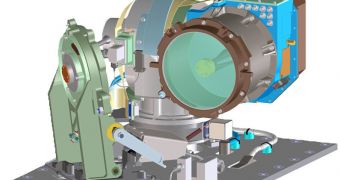Engineers in charge of the Lunar Laser Communication Demonstration (LLCD) experiment aboard the NASA Lunar Atmosphere and Dust Environment Explorer (LADEE) spacecraft say that laser communications have a very bright future in space exploration.
This conclusion is based on a 30-day experiment conducted with the LLCD, which is currently in orbit around the Moon aboard LADEE. The instrument was used to relay data back to Earth, while scientists analyzed how bright the light beam arriving here was.
Their main concern was that many of the photons traveling from the Moon to Earth would get lost, or somehow damaged during transit. However, the experiments demonstrated that not only did the laser light arrive here safely, but it did so while retaining a lot of its brightness as well.
The experiments conducted around the Moon are not the main focus of developing this type of laser communication technologies. NASA wants to use this approach to keep in touch with its spacecraft located further out in the solar system, Science Daily reports.
Naturally, it is too late to outfit these probes with lasers now, but future generations of spacecraft destined to explore planets, asteroids or comets in the solar system could feature LLCD-like systems.
The LADEE experiment was able to demonstrate data download and upload speed of up to 622 megabits per second, and 20 megabits per second, respectively. These levels are much higher than possible with existing, radio wavelengths-based technologies.
“Throughout our testing we did not see anything that would prevent the operational use of this technology in the immediate future,” says the manager of the LLCD mission, Don Cornwell. The expert holds an appointment with the NASA Goddard Space Flight Center, in Greenbelt, Maryland.
The experiment was so successful that LADEE was able to beam data back to Earth even in broad daylight, or when the Moon was located relatively close to the Sun in the sky. Even more important was the fact that all of these transmissions did not feature any errors.
“We were able to download LADEE's entire stored science and spacecraft data [1 gigabyte] in less than five minutes, which was only limited to our 40 Mbps connection to that data within LADEE,” Cornwell adds. This would have taken several days if the spacecraft's radio communications array were used.
“We were able to program LADEE to awaken the LLCD space terminal and have it automatically point and communicate to the ground station at a specific time without radio commands. This demonstrates that this technology could serve as the primary communications system for future NASA missions,” Cornwell concludes.

 14 DAY TRIAL //
14 DAY TRIAL //